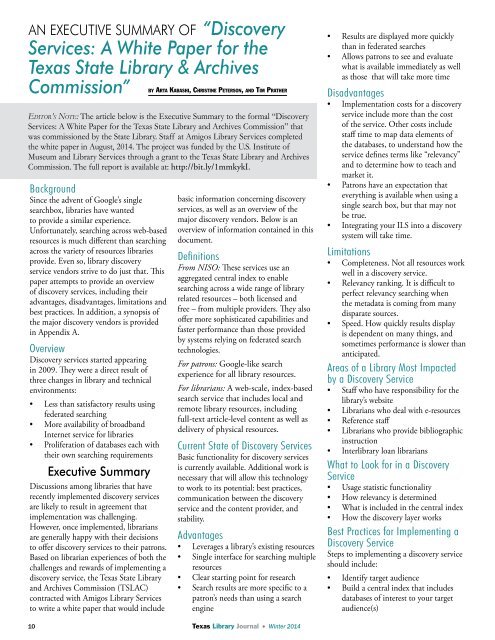Winter 2015 TLJ
Winter 2015 TLJ
Winter 2015 TLJ
You also want an ePaper? Increase the reach of your titles
YUMPU automatically turns print PDFs into web optimized ePapers that Google loves.
AN EXECUTIVE SUMMARY OF “Discovery<br />
Services: A White Paper for the<br />
Texas State Library & Archives<br />
Commission”<br />
Background<br />
Since the advent of Google’s single<br />
searchbox, libraries have wanted<br />
to provide a similar experience.<br />
Unfortunately, searching across web-based<br />
resources is much different than searching<br />
across the variety of resources libraries<br />
provide. Even so, library discovery<br />
service vendors strive to do just that. This<br />
paper attempts to provide an overview<br />
of discovery services, including their<br />
advantages, disadvantages, limitations and<br />
best practices. In addition, a synopsis of<br />
the major discovery vendors is provided<br />
in Appendix A.<br />
Overview<br />
Discovery services started appearing<br />
in 2009. They were a direct result of<br />
three changes in library and technical<br />
environments:<br />
• Less than satisfactory results using<br />
federated searching<br />
• More availability of broadband<br />
Internet service for libraries<br />
• Proliferation of databases each with<br />
their own searching requirements<br />
Executive Summary<br />
Discussions among libraries that have<br />
recently implemented discovery services<br />
are likely to result in agreement that<br />
implementation was challenging.<br />
However, once implemented, librarians<br />
are generally happy with their decisions<br />
to offer discovery services to their patrons.<br />
Based on librarian experiences of both the<br />
challenges and rewards of implementing a<br />
discovery service, the Texas State Library<br />
and Archives Commission (TSLAC)<br />
contracted with Amigos Library Services<br />
to write a white paper that would include<br />
by Arta Kabashi, Christine Peterson, and Tim Prather<br />
Editor’s Note: The article below is the Executive Summary to the formal “Discovery<br />
Services: A White Paper for the Texas State Library and Archives Commission” that<br />
was commissioned by the State Library. Staff at Amigos Library Services completed<br />
the white paper in August, 2014. The project was funded by the U.S. Institute of<br />
Museum and Library Services through a grant to the Texas State Library and Archives<br />
Commission. The full report is available at: http://bit.ly/1mmkykI.<br />
basic information concerning discovery<br />
services, as well as an overview of the<br />
major discovery vendors. Below is an<br />
overview of information contained in this<br />
document.<br />
Definitions<br />
From NISO: These services use an<br />
aggregated central index to enable<br />
searching across a wide range of library<br />
related resources – both licensed and<br />
free – from multiple providers. They also<br />
offer more sophisticated capabilities and<br />
faster performance than those provided<br />
by systems relying on federated search<br />
technologies.<br />
For patrons: Google-like search<br />
experience for all library resources.<br />
For librarians: A web-scale, index-based<br />
search service that includes local and<br />
remote library resources, including<br />
full-text article-level content as well as<br />
delivery of physical resources.<br />
Current State of Discovery Services<br />
Basic functionality for discovery services<br />
is currently available. Additional work is<br />
necessary that will allow this technology<br />
to work to its potential: best practices,<br />
communication between the discovery<br />
service and the content provider, and<br />
stability.<br />
Advantages<br />
• Leverages a library’s existing resources<br />
• Single interface for searching multiple<br />
resources<br />
• Clear starting point for research<br />
• Search results are more specific to a<br />
patron’s needs than using a search<br />
engine<br />
• Results are displayed more quickly<br />
than in federated searches<br />
• Allows patrons to see and evaluate<br />
what is available immediately as well<br />
as those that will take more time<br />
Disadvantages<br />
• Implementation costs for a discovery<br />
service include more than the cost<br />
of the service. Other costs include<br />
staff time to map data elements of<br />
the databases, to understand how the<br />
service defines terms like “relevancy”<br />
and to determine how to teach and<br />
market it.<br />
• Patrons have an expectation that<br />
everything is available when using a<br />
single search box, but that may not<br />
be true.<br />
• Integrating your ILS into a discovery<br />
system will take time.<br />
Limitations<br />
• Completeness. Not all resources work<br />
well in a discovery service.<br />
• Relevancy ranking. It is difficult to<br />
perfect relevancy searching when<br />
the metadata is coming from many<br />
disparate sources.<br />
• Speed. How quickly results display<br />
is dependent on many things, and<br />
sometimes performance is slower than<br />
anticipated.<br />
Areas of a Library Most Impacted<br />
by a Discovery Service<br />
• Staff who have responsibility for the<br />
library’s website<br />
• Librarians who deal with e-resources<br />
• Reference staff<br />
• Librarians who provide bibliographic<br />
instruction<br />
• Interlibrary loan librarians<br />
What to Look for in a Discovery<br />
Service<br />
• Usage statistic functionality<br />
• How relevancy is determined<br />
• What is included in the central index<br />
• How the discovery layer works<br />
Best Practices for Implementing a<br />
Discovery Service<br />
Steps to implementing a discovery service<br />
should include:<br />
• Identify target audience<br />
• Build a central index that includes<br />
databases of interest to your target<br />
audience(s)<br />
10 Texas Library Journal • <strong>Winter</strong> 2014


